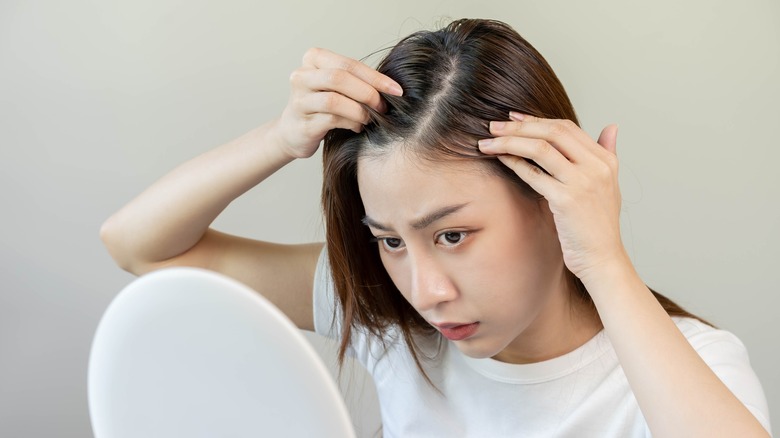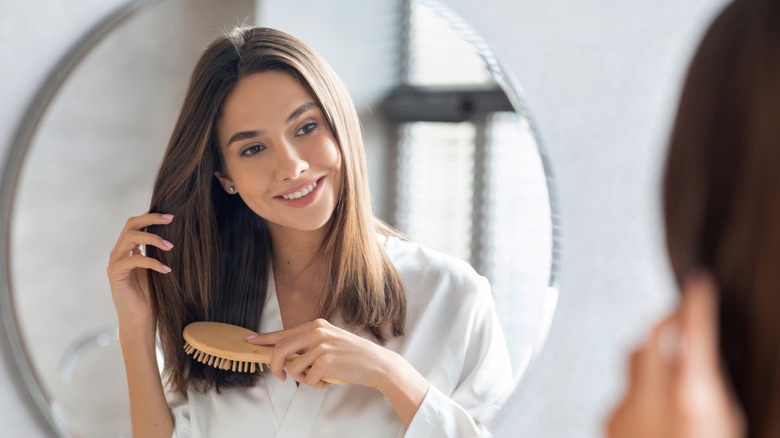How Often Does Your Hair Change Naturally?
We all know how often hair can change unnaturally. For some people, it's a new color every six weeks, or less often for semi-permanent dye. For others, it's new extensions or a sew-in weave every four weeks. While you can change your hair often, do you know how often hair changes naturally — or that it changes much sooner than age 30?
If you stop and think about it, many parts of the body change with age. Mayo Clinic provides a few examples: Skin becomes thinner and wrinkled, eyesight can deteriorate, muscles and bones can weaken, and teeth can become more prone to decay and infection. In some cases, there's a cycle involved in these changes.
According to Healthline, hair goes through a natural growth cycle over time, leaving you with hair that looks and feels slightly different at the start of a new cycle, compared to the previous one. But how often does this happen? How often does hair change naturally?
The hair growth cycle consist of four stages
It's widely known that hair grows about one inch every two months, as Live Science explains, but what's less known is that there are four stages of the hair growth process. Healthline lists them, with a description of each. The stages are anagen (growing phase), catagen (transition phase), telogen (resting phase), and exogen (shedding phase).
The length of each stage varies from person to person, but the typical full hair growth cycle is four to seven years, according to Dr. Carlos Wesley, a hair loss specialist (via Allure). So, you can expect your hair to change to some degree about every five-and-half years, on average.
Now let's take a closer look at that initial phase of the growth cycle, shall we? The anagen phase is when hairs are actively growing on your head. This stage begins when hair follicles push new hair strands out from the scalp. Echoing Dr. Wesley's statement, Healthline claims this new hair can grow for up to seven years (or longer) before it dies during the exogen phase.
Viviscal claims the anagen phase starts all over after the exogen phase ends, but over time, the length of the anagen phase decreases. This means your hair won't grow back the exact same way it did years prior. For some people, the hair can be weaker or thinner. For others, it means the hair won't grow as long. The good news is, there are ways these changes can be prevented or delayed.
How to keep hair healthy throughout the growth cycle
Although you can't stop your hair from going through each phase of the growth cycle, you can help keep it healthy throughout the process. The most obvious way is by eating food for better hair – aka a healthy, balanced diet consisting of healthy proteins and vitamins D and C, according to Healthline. Avoiding stress also helps, as Dr. Carlos Wesley told Allure. "Stress can shorten and precipitate hair loss, pushing a high percentage of hair follicles into the telogen phase," he said.
Another way to keep those locks lovely is to prevent breakage and premature shedding by using products with keratin in them. Keratin is a protein that the body produces naturally (via Cleveland Clinic). Healthline reported that a 2018 study found that keratin particles "increased hair strength by 40%." The stronger the hair, the less likely it is to break.
Anagen stimulators — products that get your hair follicles to push hairs out or lengthen the anagen phase — can help with the initial phase of the hair growth cycle, according to Verywell Health. However, it's best to speak with a dermatologist before trying any product that makes these claims.
To recap, hair changes naturally every four to seven years, which is the amount of time that hair actively grows. Hair tends to grow back differently after the end of the initial phase of the growth cycle (the anagen phase), but you can keep it healthy with a balanced diet, stress avoidance to prevent hair loss, hair products with keratin in them, and anagen stimulators.


